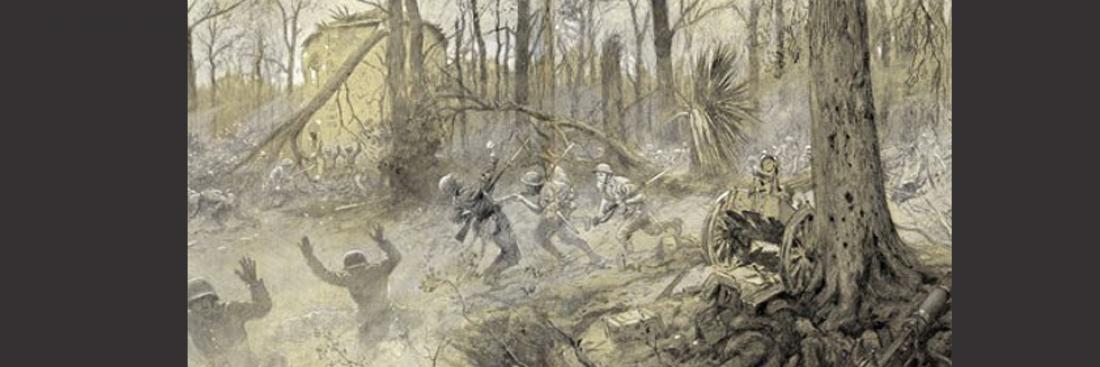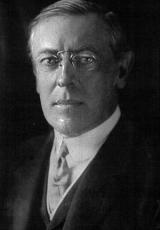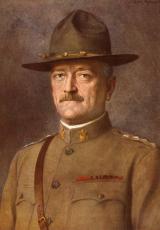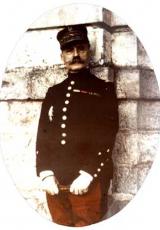1918 - Les Américains au combat

Corps 1
1918 The Americans in the War From the 26th of June 1917, the date their first contingent based at Saint-Nazaire arrived in France, the Americans progressively set an impressive war machine in motion. On the 1st of January 1918, there were 150,000 American soldiers in France. By the 11th of November, there were 2 million on the Western Front. In the course of this same year, their units, trained in camps in the United States before being sent to lines behind the front in France to complete their training under French supervision, advanced in a line in Lorraine, in relatively quiet sectors where they were subjected to an ordeal by fire. At the time, France provided the heavy artillery: about 230 tanks, 3,000 canons and thousands of aircraft.
Corps 2
Commander in Chief of the American troops, General Pershing had clear instructions from the start from his Minister for War, Baker: to cooperate with the Allies, while maintaining the integrity of his forces until able to carry out his own offensives. With this in mind, he gradually freed himself from French control and, following many discussions with Generalissimo Foch, on the 10th of August 1918 he was able to officially create the 1st American army, whose HQ were at Chaumont (Haute-Marne). The Americans arrived in France in the spring of 1918 at a steady rate of 200,000 per month, in marine convoys under the protection of their navy, commanded by Admiral Sims. Ready and waiting to be formed into an army capable of operating alone, the units of Sammies (American soldiers) were about to be gradually thrown into the furnace, when serious enemy attacks launched on the 21st March 1918 meant that they were required to support French and British troops. The whole Service of Supply infrastructure (camps, stores, communication lines, transport etc.) was then operating at full capacity and the effects of the "rising tide" of Americans contributed greatly in pushing the enemy towards defeat. From the 28th of May until the 31st July the Aisne-Marne pocket and second Battle of the Marne operations took place, at Bouresches, Bois Belleau, Château-Thierry, Fère-en-Tardenois, Nesles, Fismes, etc, where the 2nd American Infantry division (U.S.I.D.) and the marine corps distinguished themselves in particular.
From the 28th of May, the 1st U.S.I.D. attacked along the Aisne, concentrating efforts on the village of Cantigny, to the east of Montdidier, which it captured the same day, although with heavy losses (more than 1,000 killed or wounded). At the beginning of June, the 3rd U.S.I.D. succeeded in preventing German assault troops from crossing the Marne and taking Château-Thierry. The 2nd U.S.I.D., who had received the order to relieve the 1st U.S.I.D. at Cantigny, took Bouresches. Despite their inferior numbers, the Marines (5th and 6th Regiments of marine fusiliers) completely liberated le bois Belleau, situated slightly to the east of Château-Thierry, between the 6th and the 25th of June, The battle is considered today to be the first major engagement and founding moment of the reputation of the Marines.
In his memoirs, General Pershing analysed this participation in the fighting: "The 3 American divisions, taking part in the fighting for the first time, all distinguished themselves: the 1st at Cantigny, the 2nd at le bois Belleau and the 3rd at Château-Thierry. Their conduct under fire was a foretaste of everything that trained American troops could achieve". General Pershing, Mes souvenirs de guerre, (My Experiences in the World War) Librairie Plon, 1931 From August to October, the allied armies extended the theatre of war to the Somme, Artois and Flanders, where the 27th, 30th, 33rd and 80th U.S.I.D. all distinguished themselves. With his 1st army, Pershing launched the Franco-American offensive, which between the 12th and 14th of September, reduced the Saint-Mihiel salient in the Meuse: 15,000 enemy soldiers were taken prisoner.
Victory was quickly secured, mainly due to the tanks, canons and aircraft loaned by the Commander in Chief of the French armies. It was also facilitated by exhausting the enemy, who had shortened their front by retreating towards their Hindenburg line, between Etain and the Moselle. During the attack, the tanks were commanded by an officer whose reputation was to shine through in 1944: Patton, who was a colonel at the time. On the 25th of September, the offensive of the 4th French army (General Gouraud) and the 1st US army began, with the Ardennes as their objective. The Americans cleared the Argonne, freed Verdun and headed northwards on both sides of the Meuse. Following fierce fighting and losing time, Marshal Foch had to back up this progress with French reinforcements from the 1st of October onwards. The 3rd, 2nd and 36th U.S.I.D. captured the formidable Blanc Mont Ridge.
According to Leonard Ayres, head of the American army's statistics department, the losses of the expeditionary corps during the Argonne campaign amounted to about 22,000 dead, or almost half of the total of American losses during the Great War.
On the 12th of October, a second American army was created and then a third on the 7th of November. The Americans reached Sedan the same day. Fighting furiously, the French crossed the Meuse at Vrigne on the 10th, whilst further north towards Rocroi, they arrived in Belgium. An armistice was requested on the 9th by Germany. General Pétain had prepared for a great offensive in Lorraine, arranged for the 14th of November 1918, which would have led Franco-American troops into Germany. But it was abandoned as, against his opinion and that of General Pershing, who did not want the signing of the armistice to take place until the enemy had been driven back beyond the Rhine, General Foch and Clemenceau accepted the request and signed the armistice on the 11th of November. On the 21st November the Americans arrived in the liberated capital of the Grand Duchy of Luxembourg and carried on into the Rhineland on the 23rd. They reached the Rhine and Koblenz, via the Moselle valley, on the 9th of December. On the 14th of July 1919, they marched with all the Allies under the Arc de Triomphe in Paris, during Victory celebrations.
During the course of the war, along the fronts of France, Belgium and Italy, more than 50,000 Sammies were killed in action or died in hospital from their injuries. Tens of thousands more died from disease or were victims of accidents. In January 1919, at the beginning of the Versailles negotiations, Wilson defended his views: a reduction in armaments, liberation of the colonies, free movement at sea and, most importantly, the creation of the League of Nations, intended to guarantee peace and the new European borders. But the American Senate refused to ratify the treaty of Versailles in November 1919, initiating the return to isolationism of the United States of America, which was then able to take over from a Europe that was failing both economically and financially.
Related articles
Commemorative sites
- Franco-american museum at the château de Blérancourt
- Montsec American Monument
- Museum of Flandres
- "Musée des ""Deux Victoires"", Mouilleron-en-Pareds"
- Saint-Mihiel Salient
- The Georges Clemenceau Museum
- Cerny-en-Laonnois – Cemeteries and chapel
- The National Necropolises at Soupir
- Musée d'Argonne
- Moulin de Laffaux
- Monument de l'artillerie spéciale, Méry-la-Bataille
- La salle du "Commandement Unique" à Doullens
- Vendresse




